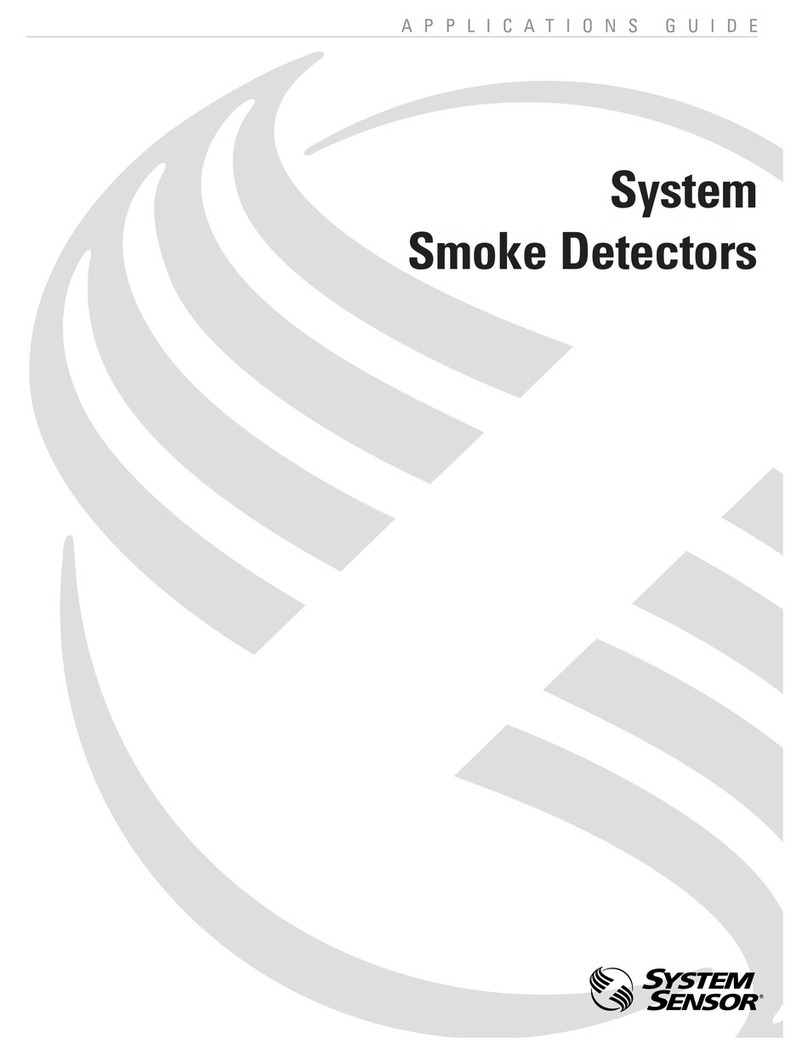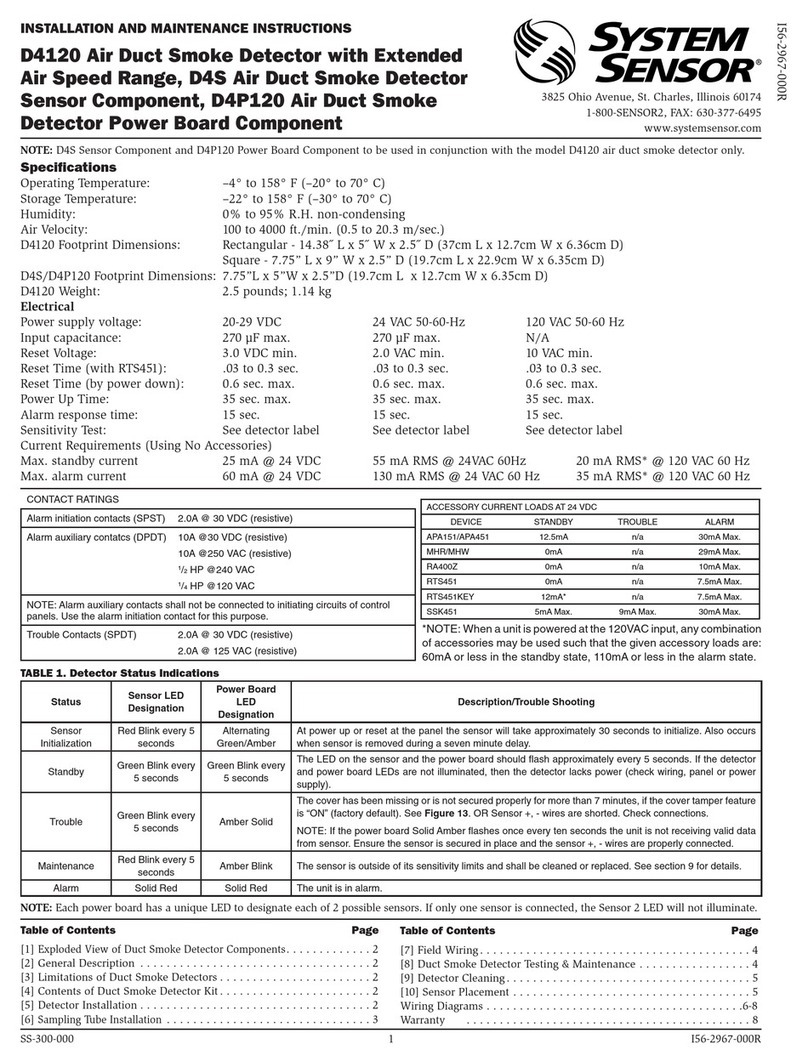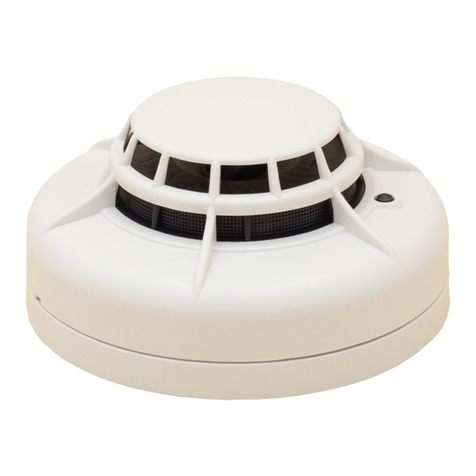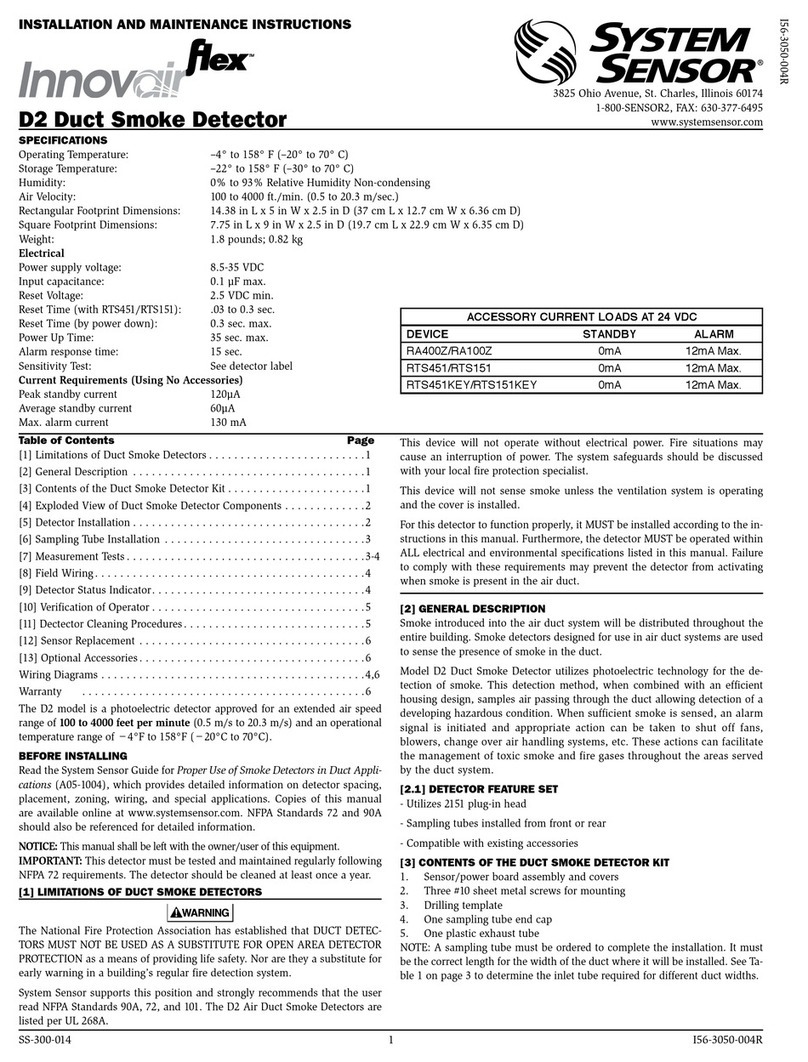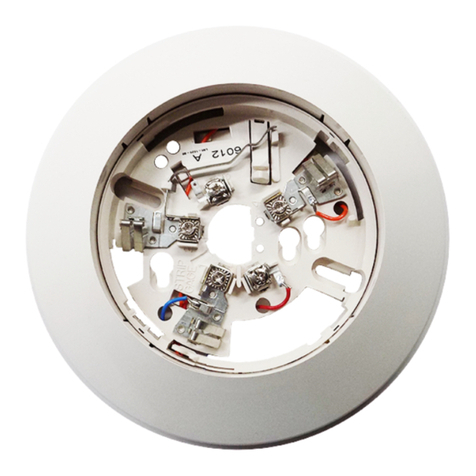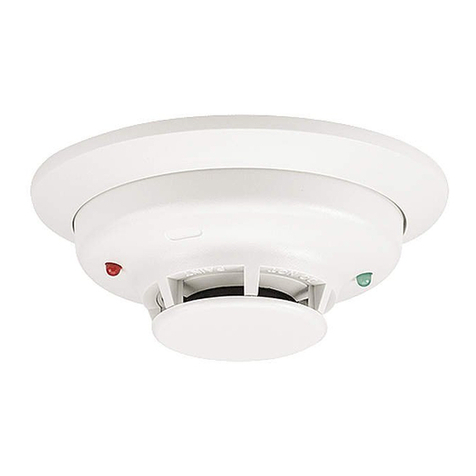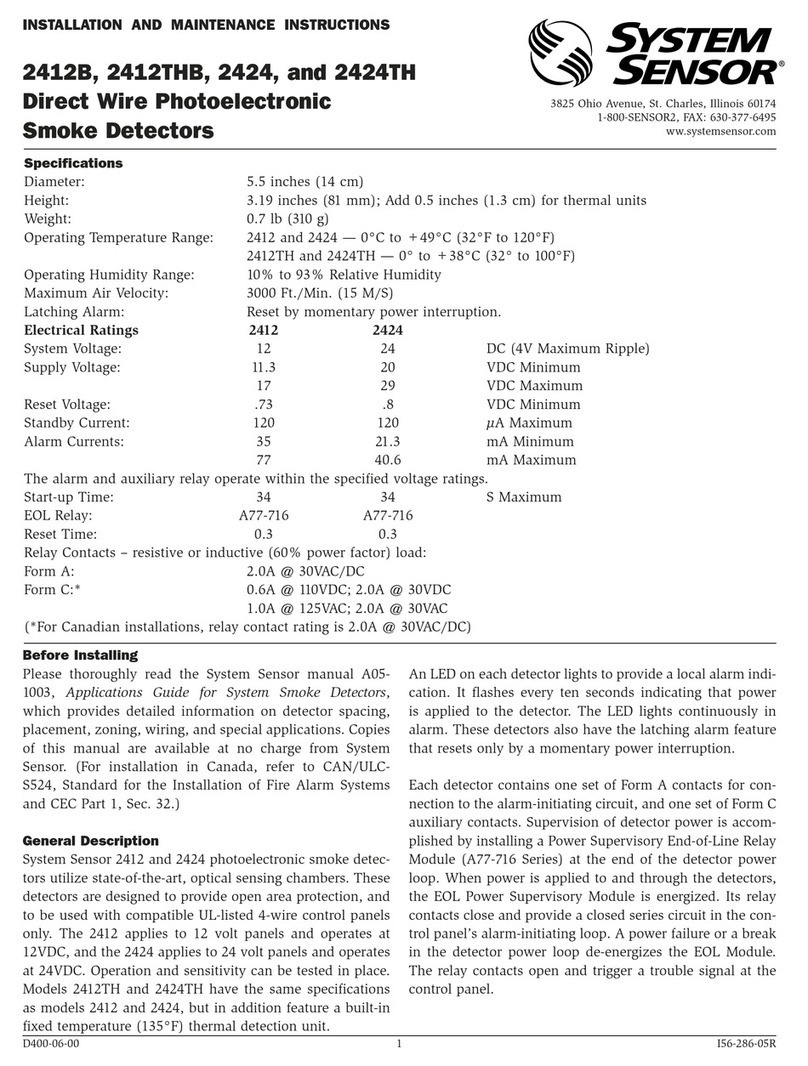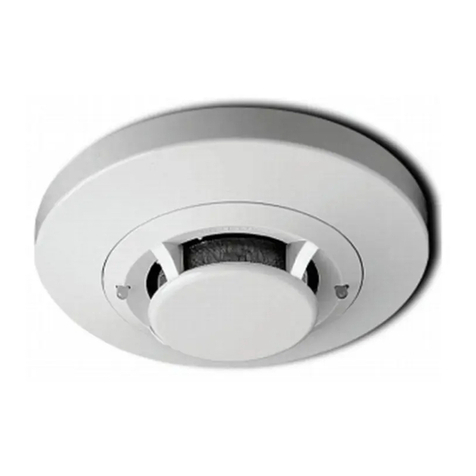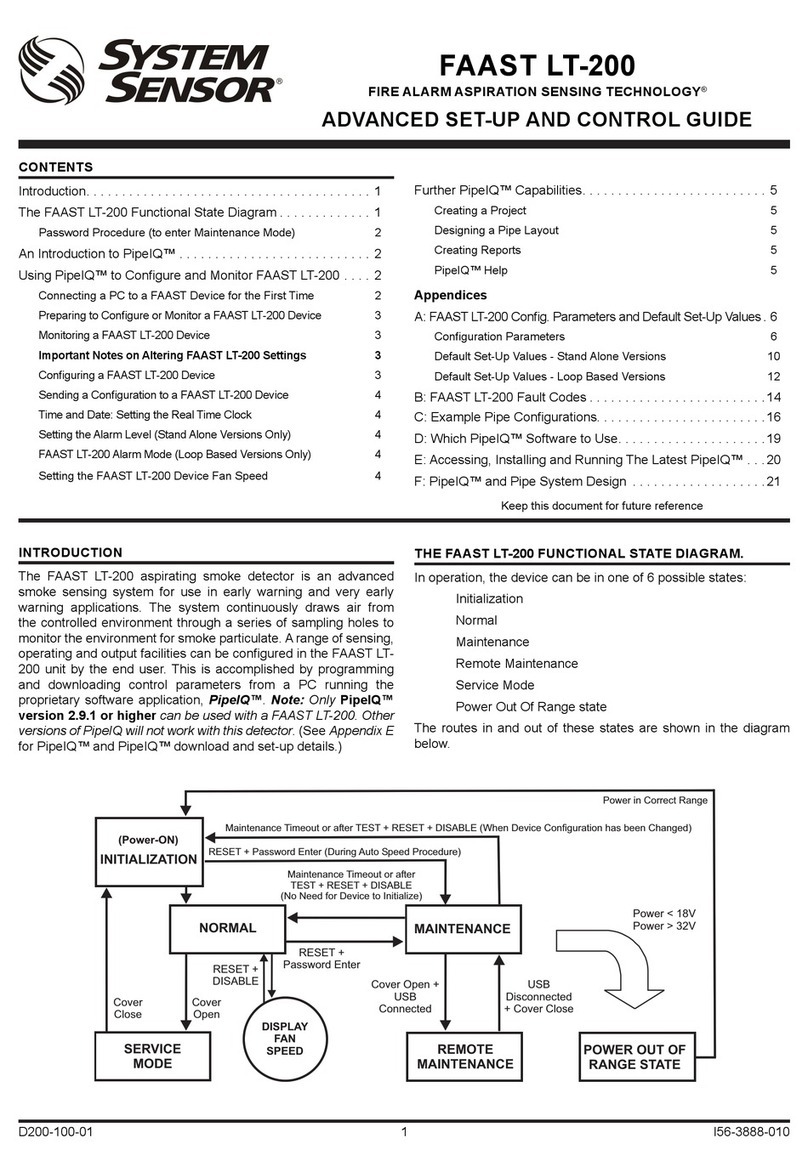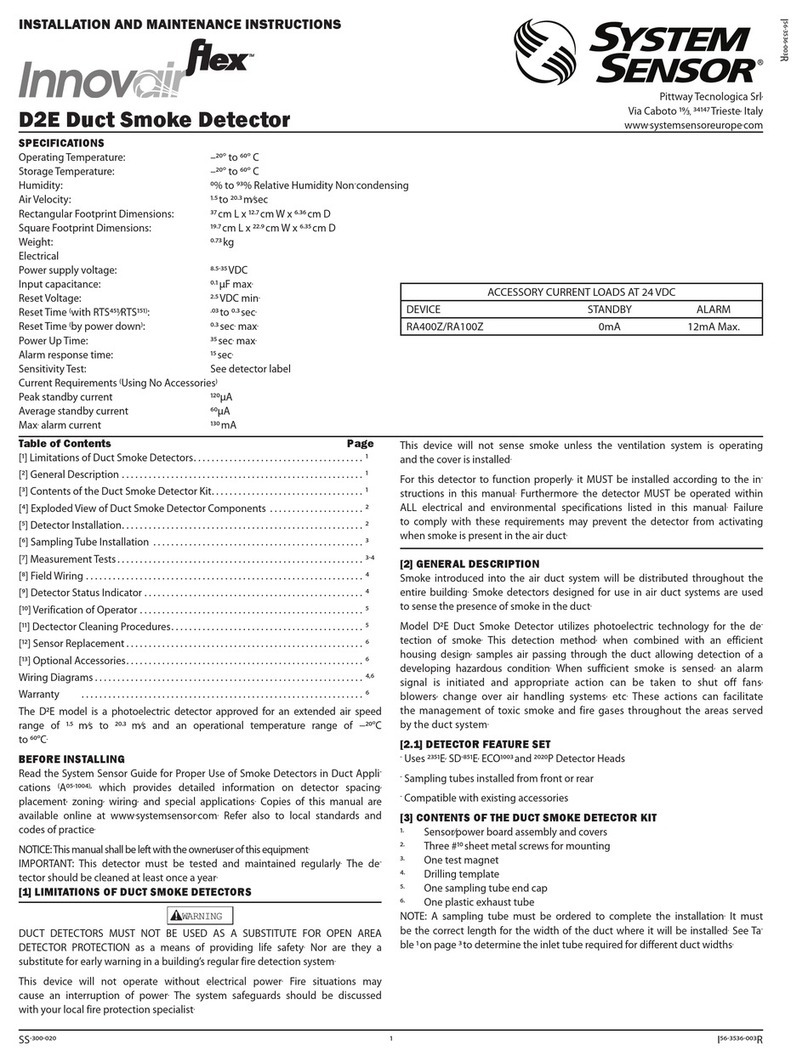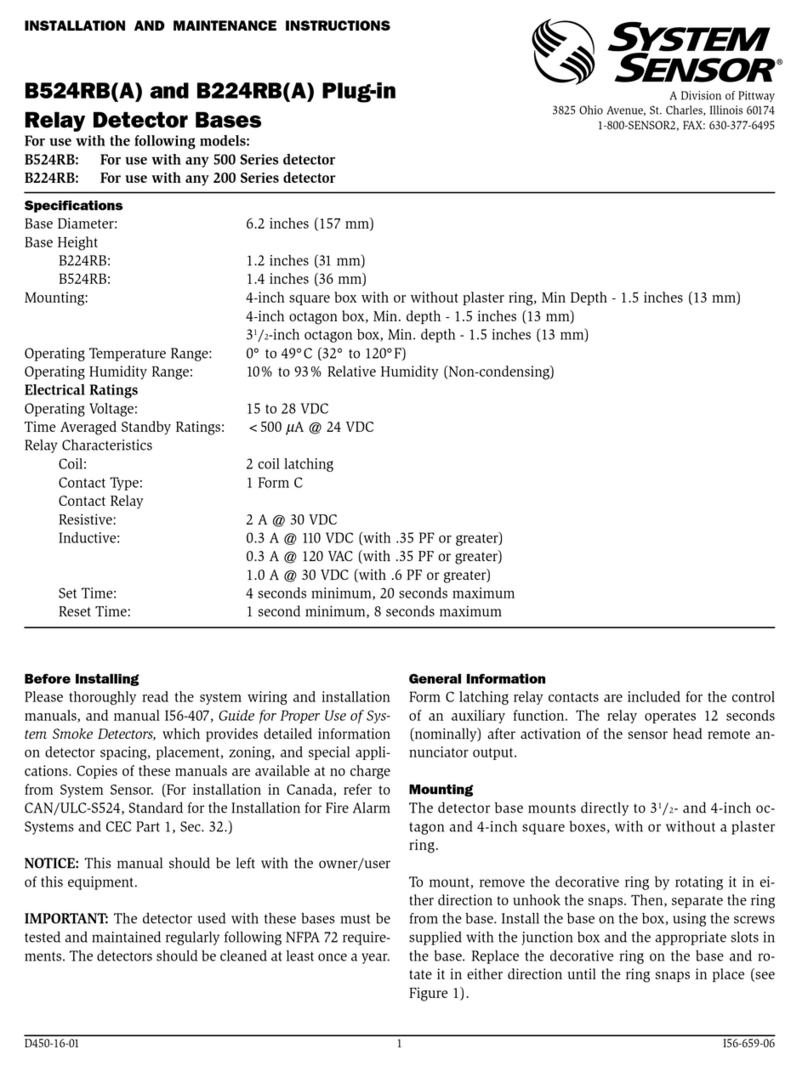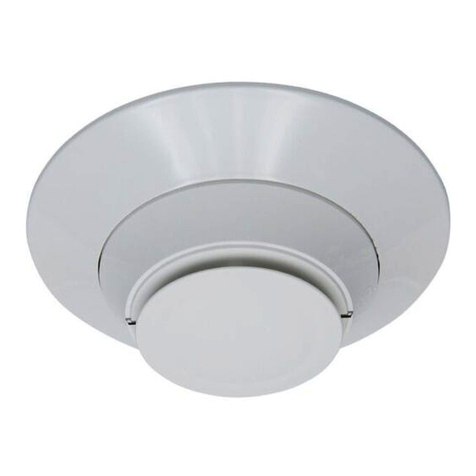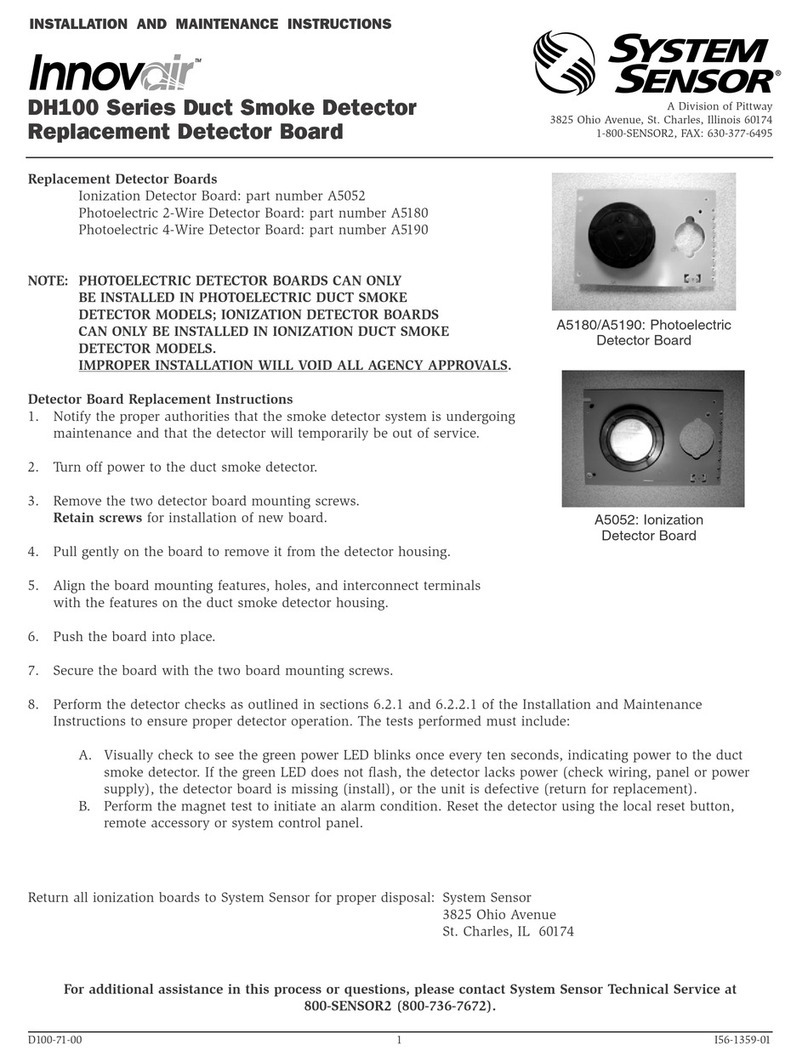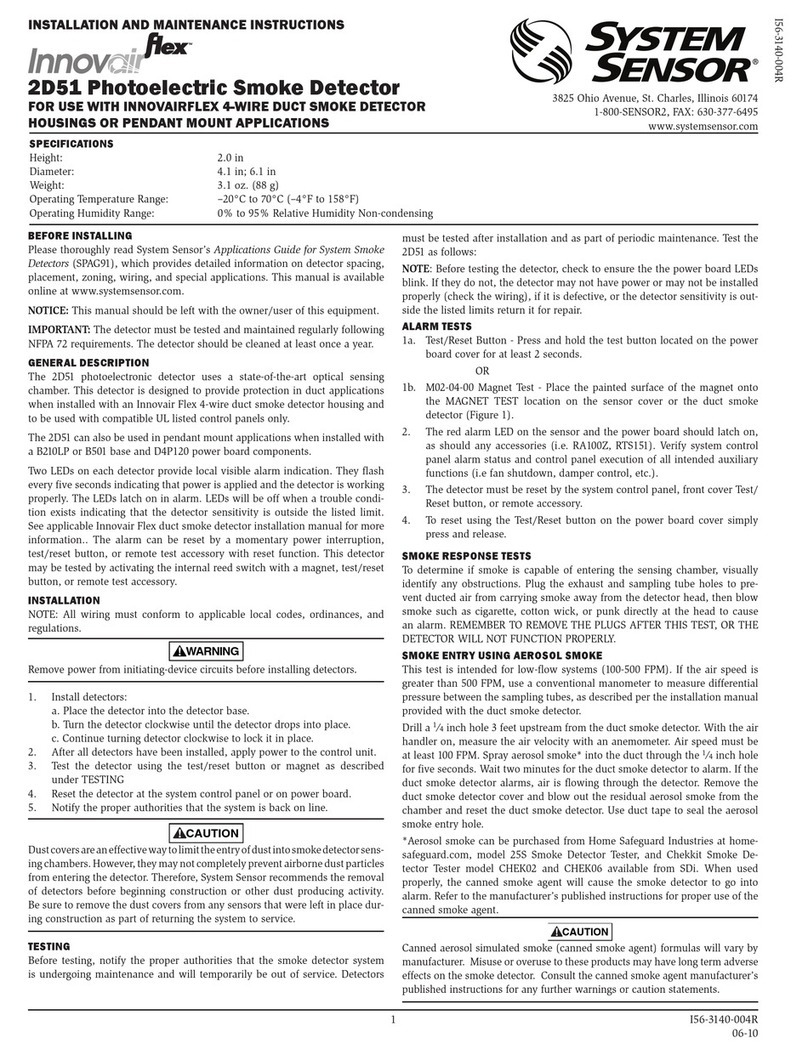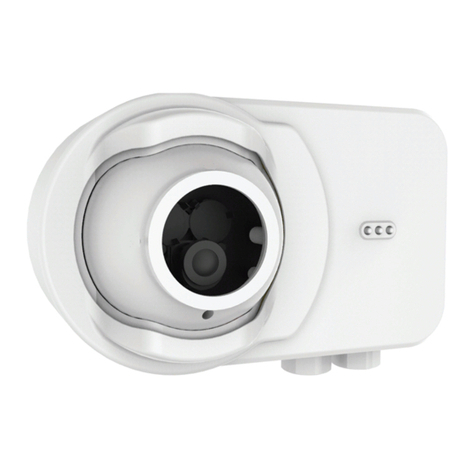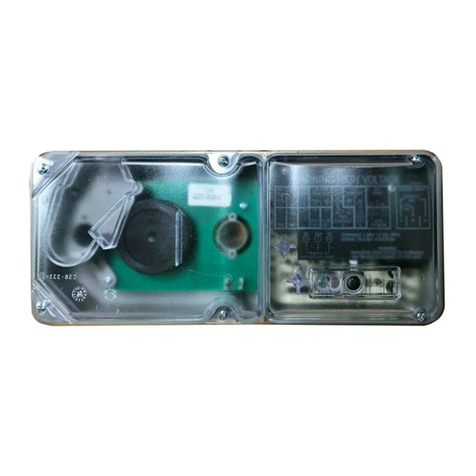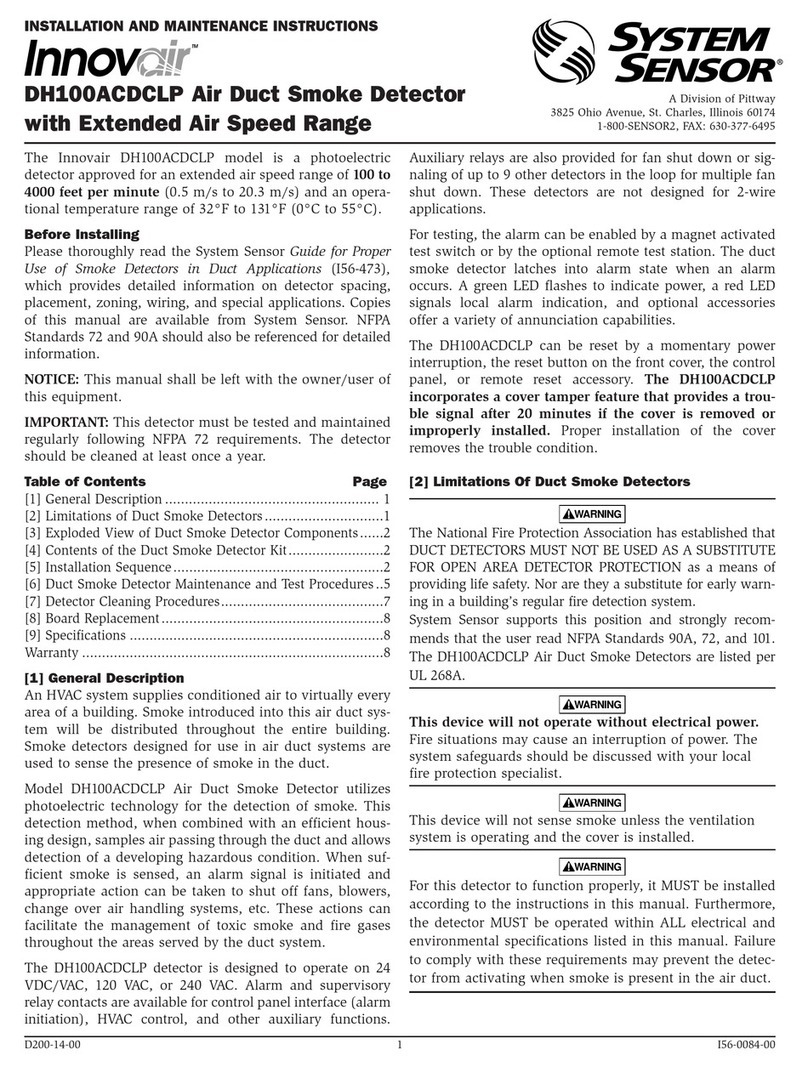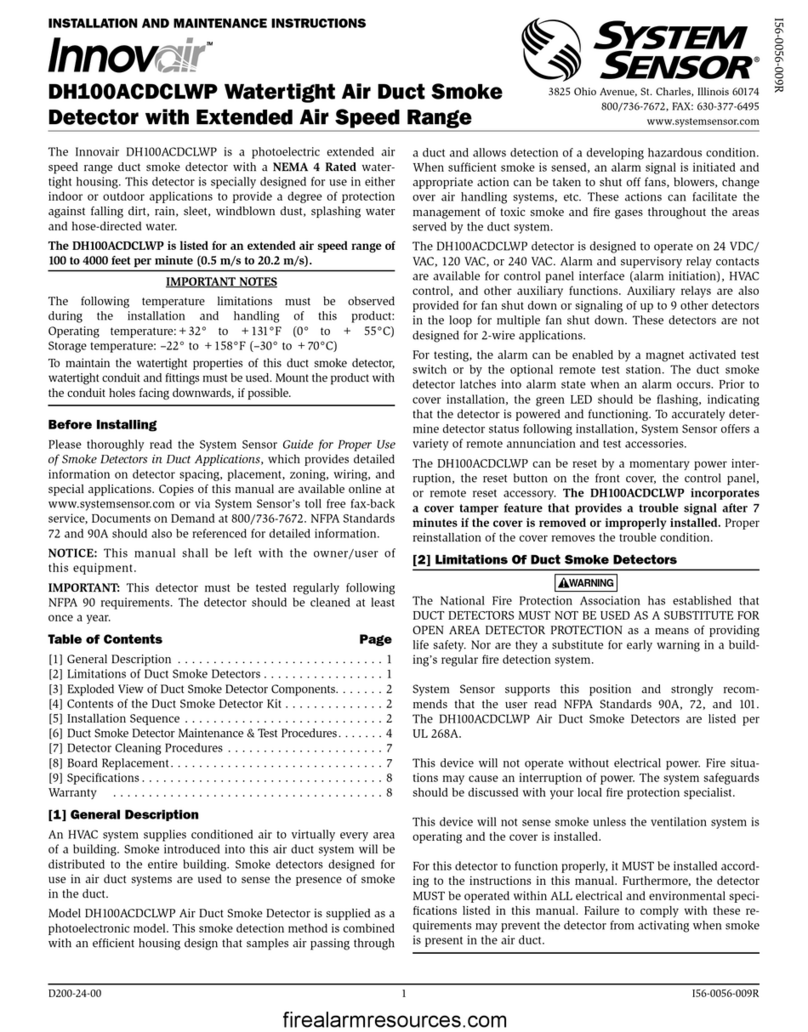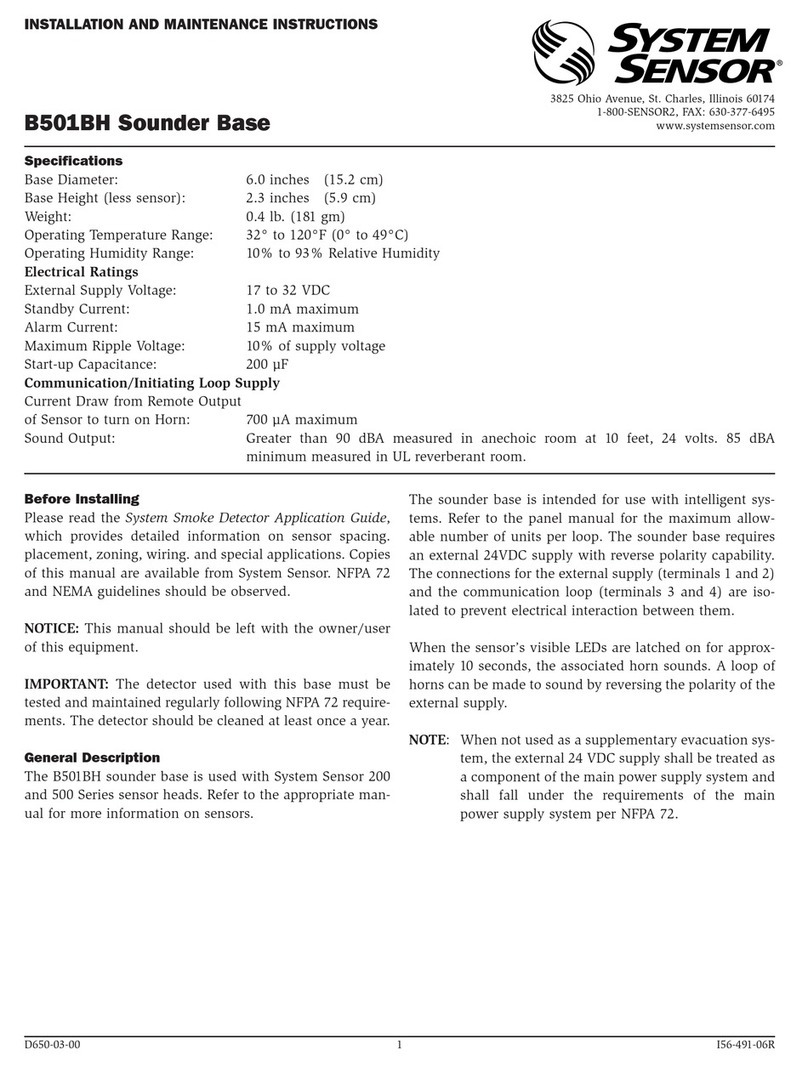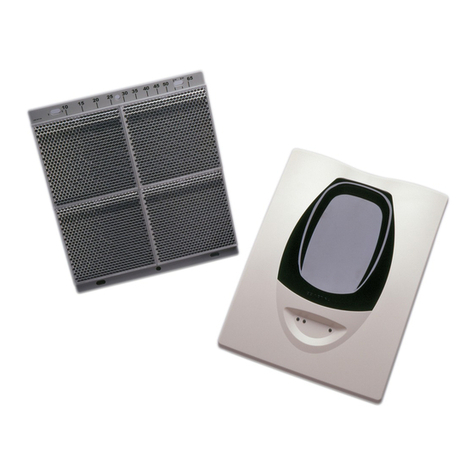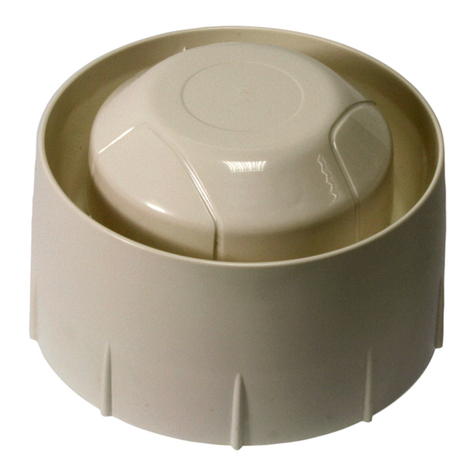
–
+
COMPATIBLE
CONTROL PANEL
(–) COM LINE
TO REST OF SYSTEM
(+) COM LINE
TO REST OF SYSTEM
LOOP
LOOP
UNIT 2
UNIT1 UNIT 3
COMM (+)
COMM (–)
(+) OUT
COMM (+)
COMM (–)
(+) OUT
COMM (+)
COMM (–)
(+) OUT
FIGURE 10. DNRE USING A TEST COIL
DCOIL
TEST COIL SCREW
[11] ADDITIONAL MODULE OPTION
The DNRE can also accommodate a relay or control module (sold separately)
within the power board side of the housing. The relay or control module must
be listed as compatible to the fire alarm control panel.
Physical Module Mounting
1) Remove the breakaway tabs at the four corners of the module
2) Locate the module at right most corner of the power board. The upper
left corner mounting hole of the module will align with a screw boss in
the housing.
3) Install a M4X0.7, 9.5 mm long thread forming screw at the screw boss location
Note: See the corresponding module Installation Instructions for general
description, control panel compatibility, wiring and ratings.
SS-300-021 5 I56-3538-003R
[6.2]LOW FLOW AIR FLOW TEST USING DWYER SERIES 607
DIFFERENTIAL PRESSURE TRANSMITTER
Verify the air speed of the duct using an anemometer. Air speed must be at
least 1.5 m/sec. Wire the transmitter as shown in Figure 5. Connect the leads
of the meter to either side of the 1000Ωresistor. Allow unit to warm up for
15 seconds. With both HIGH and LOW pressure ports open to ambient air,
measure and record the voltage drop across the 1000Ωresistor (measurement
1), 4.00 volts is typical. Using flexible tubing and rubber stoppers, connect the
HIGH side of the transmitter to the sampling tube of the duct smoke detec-
tor housing, and the LOW side of the transmitter to the exhaust tube of the
duct smoke detector housing. Measure and record the voltage drop across the
1000Ωresistor (measurement 2). Subtract the voltage recorded in measure-
ment 1 from the voltage recorded in measurement 2. If the difference is greater
than 0.15 volts, there is enough air flow through the duct smoke detector for
proper operation.
[7]FIELD WIRING; INSTALLATION GUIDELINES
All wiring must be installed in compliance with local wiring regulations.
Proper wire gauges should be used. The conductors used to connect smoke
detectors to control panels and accessory devices should be color-coded to
prevent wiring mistakes. Improper connections can prevent a system from
responding properly in the event of a fire.
For signal wiring (the wiring between detectors or from detector to auxiliary
devices), it is usually recommended that single conductor wire be no smaller
than 18 gauge. The duct smoke detector terminals accommodate wire sizes up
to 12 gauge. Flexible conduit is recommended for the last 30 cm of conduit;
solid conduit connections may be used if desired.
Duct smoke detectors and alarm system control panels have specifications for
Signaling Line Circuit (SLC) wiring. Consult the control panel manufacturer’s
specifications for wiring requirements before wiring the detector loop.
[7.1]WIRING INSTRUCTIONS
Disconnect power from the communication line before installing the DNRE
duct smoke detector.
The DNRE detectors are designed for easy wiring. The housing provides a ter-
minal strip with clamping plates. Wiring connections are made by sliding the
bare end under the plate, and tightening the clamping plate screw. See Figure
6on below for system wiring.
[7.2] SET THE ADDRESS
Set the desired address on the sensor head code wheel switches. on the back
of the sensor head.
SS-300-021 4 I56-3538-003R
FIGURE 6. SYSTEM WIRING DIAGRAM FOR DNRE:
HO119-04
HO112-03
Two LEDs on the sensor are controlled by the panel to indicate sensor
status. Coded signals, transmitted from the panel, can cause the LEDs
to blink, latch on, or latch off. Refer to the control panel technical docu-
mentation for sensor LED operation and expected delay to alarm.
[8.4.2] THE DETECTOR MUST BE RESET BY THE SYSTEM CONTROL PANEL
[8.4.3]SMOKE ENTRY TEST USING AEROSOL SMOKE
This test is intended for low-flow systems (1.5-254 m/sec). If the air speed is
greater than 2.54 m/sec, use a conventional manometer to measure differen-
tial pressure between the sampling tubes, as described under Measurement
Tests on Page 3.
Drill a .63 cm hole 91.4 cm upstream from the duct smoke detector. With the
air handler on, measure the air velocity with an anemometer. Air speed must
be at least 1.5 m/sec. Spray aerosol smoke into the duct through the .63 cm-
hole for five seconds. Wait two minutes for the duct smoke detector to alarm.
If the duct smoke detector alarms, air is flowing through the detector. Remove
the duct smoke detector cover and blow out the residual aerosol smoke from
the chamber and reset the duct smoke detector at the panel. Use duct tape to
seal the aerosol smoke entry hole. Remember to replace the cover after the test
or the detector will not function properly.
Canned aerosol simulated smoke (canned smoke agent) formulas will vary by
manufacturer. Misuse or overuse to these products may have long term adverse
effects on the smoke detector. Consult the canned smoke agent manufacturer’s
published instructions for any further warnings or caution statements.
[9]DETECTOR CLEANING PROCEDURES
Notify the proper authorities that the smoke detector system is undergoing
maintenance, and that the system will temporarily be out of service. Disable
the zone or system undergoing maintenance to prevent unwanted alarms and
possible dispatch of the fire department.
[9.1]DETECTOR SENSOR
1. Remove the sensor to be cleaned from the system.
2. Refer to the relevant detector installation manual for cleaning instructions.
3. Reinstall the detector.
[9.2]REINSTALLATION
1. Reinstall the detector in its housing.
2. Restore system power.
3. Perform Detector Check.
4. Notify the proper authorities testing has been completed and the smoke
detector system is back in operation.
[10]SENSOR REPLACEMENT
1. Remove the sensor head by rotating counterclockwise.
2. Pull gently to remove it.
3. To replace the sensor head, align the mounting features and rotate clock-
wise into place.
[11] OPTIONAL ACCESSORIES
Optional accessories include RA400Z/RA100Z, RTS451/RTS151 and
RTS451KEY/RTS151KEY and 6500RTS-KEY.
NOTE: Ensure blue wire always remains connected to RA+ terminal.
FIGURE 8. WIRING DIAGRAM FOR DNRE TO RA400Z/RA100Z:
(+)
(-)
RA400Z/RA100Z
– RA
REMOTE ALARM LED
OPTION 1 PER UNIT
H0570-03
Note: If using a RA400Z, the tab should be broken for use with the intelli-
gent duct smoke detector. If using RA100Z, ensure that jumper is removed.
The RTS451/RTS151/RTS451KEY/RTS151KEY Remote Test Station facilitates
test of the alarm capability of the duct smoke detector. These accessories pro-
vide the stimulus to initiate an alarm condition at the detector. The DNRE duct
smoke detector must be reset by the system control panel.
Note: Some panels support extended addressing. In order to set the sensor
above the address number 99 on compatible systems, carefully remove the
stop on the left hand rotary switch with pliers as shown in Figure 7.
NOTE: Verify sensor cover gasket is properly seated on cover prior to cover
installation
[8] VERIFICATION OF OPERATION
[8.1]INSTALL THE COVER
Install the covers making sure that the cover fits into the base groove. Tighten
the seven screws that are captured in the covers. Note that the cover must be
properly installed for proper operation of the sensor.
[8.2] POWER THE UNIT
Activate the communication line on terminals COM + and COM –.
[8.3] DETECTOR CHECK
Standby – If programmed by the system control panel, look for the presence of
the flashing LEDs through the transparent housing cover. The LED will flash
with each communication.
Trouble – If programmed by the system control panel and the detector LEDs
do not flash, then the detector lacks power (check wiring, missing or improp-
erly placed cover, panel programming, or power supply), the sensor head is
missing (replace), or the unit is defective (return for repair).
[8.4]DUCT SMOKE DETECTOR TEST & MAINTENANCE PROCEDURES
Test and maintain duct smoke detectors in accordance with local fire regula-
tions and practice. The tests contained in this manual were devised to assist
maintenance personnel in verification of proper detector operation.
Before conducting these tests, notify the proper authorities that the smoke
detection system will be temporarily out of service. Disable the zone or system
under test to prevent unwanted alarms.
[8.4.1]TEST THE UNIT
1. M02-04-00 Magnet Test – This sensor can be functionally tested with a
test magnet. The test magnet electronically simulates smoke in the sens-
ing chamber, testing the sensor electronics and connections to the control
panel.
2. Remote Test Accessory – The use of a remote accessory for visible indica-
tion of power and alarm is recommended.
Verify system control panel alarm status and control panel execution of all
intended auxiliary functions (i.e. fan shutdown, damper control, etc.).
H0561-01
EXTERNAL
(-) POWER (+)
SUPPLY
*
RTS451/151,
RTS451/151KEY
REMOTE TEST STATION
LED OPTION
1 PER UNIT
10mA CURRENT DRAW
TEST COIL OPTION
1 PER UNIT
95mA CURRENT DRAW
45
321
TEST COIL +
TEST COIL –
COMM +
OUT (CONV ONLY) +
COMM –
RA/RTS –
RA +
RTS +
NOTE: THE RTS451/151, RTS451/151KEY TEST COIL
CIRCUIT REQUIRES AN EXTERNAL 24 VDC POWER
SUPPLY.
NOTE: THE USE OF A REMOTE TEST STATION REQUIRES THE
INSTALLATION OF AN ACCESSORY COIL, PART NUMBER DCOIL. H0571-14
FIGURE 9. WIRING DIAGRAM FROM DNRE TO RTS451/RTS451KEY/
RTS151/RTS151KEY AND 6500RTS-KEY:
FIGURE 7. ROTARY ADDRESS SWITCHES
